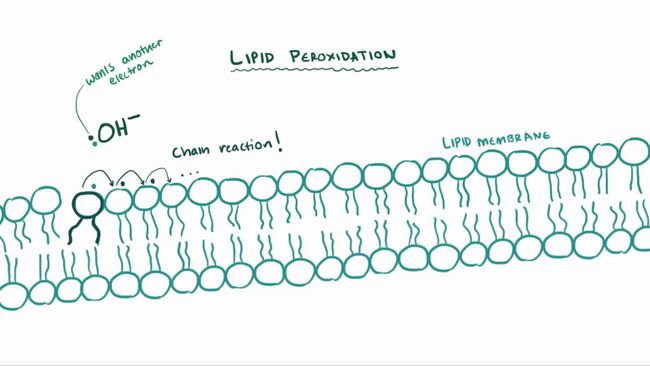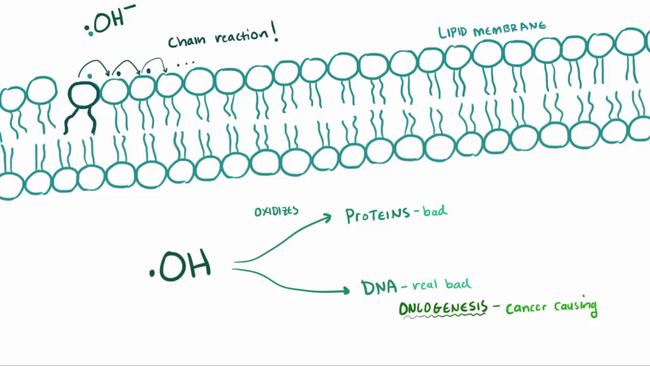【英文】Osmosis【翻译】@尔墨【校对】itsmelan【Quizlet】词表
什么是自由基?
啥是自由基?自由基是一种带有一个未成对电子的化学物质,这个电子位于它的外层轨道。举个例子,可能是最为人熟知的例子,氧气。一般氧气在这里有四对电子,但是在自由基状态下,它可能获得一个额外的电子。因此你现在有了一个未成对电子,我们叫它自由基。它就是带来所有麻烦的元凶,有导致细胞损伤的潜在可能。自由基极有可能在正常生理状态下产生,也可能在异常病理状态下产生。
So what exactly is a free radical? It’s a chemical species with an unpaired electron in its outer orbit. One example, and probably actually the most well-known example, is oxygen. Normally oxygen’s got the 4 pairs of electrons here, but in a free-radical situation, it might GAIN an extra electron, so now you’ve got this one unpaired electron and we call this guy a free radical and it’s what causes all the trouble and potentially can cause cellular injury. Free radicals are generated both normally in physiologic conditions and abnormally in pathological conditions.
生理状态下产生自由基
生理状态下,也就是正常情况下,它可以在氧化磷酸化期间发生。这是我们所知的细胞中非常重要的生成ATP的过程。在此过程中,有一种叫做细胞色素C氧化酶的分子,有时也叫做复合物IV。这个分子将电子传递给氧,氧欣然接受这些电子。这些电子依次引起线粒体基质泵出质子,形成质子梯度,驱动ATP的产生。一般氧气接受4个电子,并形成水。
Physiologically, so we’re talkin’ like in normal conditions, it can happen during oxidative phosphorylation, which we know is this super important process in our cells to make ATP. During this process, you’ve got this molecule called cytochrome c oxidase, or sometimes it’s known as complex IV. This molecule transfers electrons to oxygen, and oxygen gladly accepts those electrons, and this in turn causes the mitochondrial matrix to pump protons out. And this creates our proton gradient and drives the production of ATP. So normally, for oxygen to be happy it accepts 4 electrons and becomes water.
但是如果它没有接受全部的4个质子呢?好的,朋友们,这时自由基就出现了。如果氧气获取1个电子,它就成为了超氧化物,用O2加上一个点表示额外的电子。如果获取2个电子,它就成了过氧化氢。然后3个电子,它就成了羟基自由基。最后,如果获取4个电子,就得到了水。所以1、2、3个电子都叫做氧的部分还原。氧并没有被完全还原为水,因为还原是得电子,在这种情况下它只被部分还原。也要记得,这是生理状况下发生的,也就是正常情况。
But what if it doesn’t receive all 4? Well that, my friends, is when we get free radicals. Okay so if Oxygen grabs one electron, it becomes SUPERoxide, so O2 with a little dot for its extra electron. If it gets two electrons, it becomes hydrogen peroxide, and then 3 electrons, it’s hydroxyl radical, then finally if you get all four electrons you get water. So 1, 2, or 3 electrons is called a partial reduction of oxygen, so oxygen isn’t being reduced all the way to water, because remember that reduction is a gain of electrons, so in this case it’s only partial. And remember that this happens physiologically, in like normal conditions.
病理状态下产生自由基
同样,在病理状况下也可以产生自由基,也就是异常情况。
Also though, you can generate free radicals in pathological conditions too, so not normal conditions.
1. 通过电离辐射
一条途径是通过电离辐射,这通常产生羟基自由基。这发生在射线进入并轰击身体组织中的水分子的时候。它轰击H2O对吧?它敲除一个电子,如果你从水回溯,你最终将得到一个羟基自由基。这些羟基自由基总体上是活性最强的,因此对你的细胞损伤可能时最大的。
One way is through ionizing radiation, and this usually generates a hydroxyl radical. And this’ll happen when the radiation sort of comes in and hits water in your tissue, so it hits the h2o right? And it knocks off an electron, and if so if you go backwards here from water, you’ll end up at the hydroxyl radical. And these hydroxyl free radicals are generally the most reactive, and so therefore probably the most damaging to your cells.
2. 炎症
除了电离辐射,炎症是产生自由基的另一条途径。当你被感染,中性粒细胞趋化以对抗感染时,它们利用两种机制来杀死一切入侵的微生物。其中一种是需氧的。需氧的意思是需要氧气,对吧?因此我们可以猜想,氧气被包含在内!通常这个过程始于氧化爆发,一种叫做NADPH的氧化酶夺取氧气并将它转化为超氧化物。然后它最终被转化为漂白液,也就是次氯酸。但是NADPH将氧气转化为超氧化物的过程是产生自由基第一步。
Besides ionizing radiation though, Inflammation is another way though that you can get free radical generation. When you get an infection and neutrophils come by to fight that infection, there are two mechanisms they use to kill whatever microbe there is, oxygen dependent and independent. Oxygen dependent means you need oxygen right? So we can probably guess that oxygen’s involved! Usually this starts with what’s called an oxidative burst, where an enzyme called NADPH oxidase takes your oxygen and converts it to superoxide (O2-), and then it goes on to be eventually converted into bleach, or HOCL. But mainly our culprit for producing free radicals is gonna be this first step where NADPH converts oxygen to superoxide.
3. 和金属接触
产生自由基的第三种途径是通过和金属的接触,通常是体内的金属离子。比如铜离子、铁离子,它们一般结合在其他物质上。举个例子,有一种叫做转铁蛋白的物质,这些蛋白质结合铁离子,并帮助控制血中铁的含量。为什么我们要确保它被控制呢?因为如果铁离子不被结合,也就是不受控制,它就会产生自由基。芬顿反应允许铁离子产生自由基,通常是羟基自由基,最为危险的一类!
Another way this can happen too is through contact with metals, and we’re usually talking about metals in the context of the body, so like copper or iron, right? Where they’re usually bound to something? One example something are called tranferrins, these proteins bind iron and sort of help you control the amount of iron in your blood. Why do we wanna make sure it’s controlled? Well because if it’s not bound, it can generate free radicals. A reaction called the fenton reaction allows iron to generate a free radical, usually the hydroxyl free radical, our most dangerous guy!
让我们在疾病的背景下思考,比如血色素沉着症。这是由铁导致的,产生严重的组织损伤,比如肝硬化。这背后的主要机制就是自由基的产生!类似地,在Wilson病中,自由铜离子过量,也就是没有结合的铜离子。同样,这些自由基导致了组织损伤。
So let’s think about it in the context of some disease, like hemochromotosis. Where iron builds up, and you get serious tissue damage, like cirrhosis in the liver. The primary mechanism behind this is a buildup of free radicals! Similarly, in wilson’s disease, you there’s an excess of free copper, so copper that’s not bound. You also end up getting this tissue damage from free radicals.
4. 药物和化学物质
最后,药物和化学物质也能产生自由基。比如扑热息痛,和许多其他药物一样进入肝脏代谢。P450系统是肝脏中非常重要的药物代谢酶类,它们承担这个任务。代谢过程中会产生自由基,也就是说当摄入大剂量扑热息痛会导致大量肝脏组织坏死,主要原因是自由基的损伤作用。
Finally, there’re drugs and chemicals that can produce free radicals. For example a drug like acetaminophen, which, like many other drugs goes to the liver to be metabolized. In the liver, the P450 system takes care of it, which is like this group of really important drug-metabolizing enzymes. This metabolizing though, can generate free radicals, and so when high doses of acetaminophen are taken, it can cause massive death of tissue in the liver, and this is mainly from free radical damage.
自由基如何损伤细胞?
以上就是自由基导致损伤的内容。但是它们究竟是如何损伤细胞的呢?一种主要途径是脂质过氧化,意思是它们能够从细胞膜脂质上夺取一个电子。还记得它们有一个不成对电子吗?因此它们想要另一个电子来配对。它们从细胞膜脂质上获取一个电子,只给脂质留下一个不成对电子。这样的脂质会对其他的脂质做同样的事情,就像是链式反应一样蔓延。正如你所想象的一样,这回损伤细胞膜,并完全摧毁细胞。
So how do free radicals injure cells? Well one big way is called lipid peroxidation. Meaning that they can sort of steal an electron from the lipids of cell membranes. Remember that they have this unpaired electron, so they want another electron to be its pair, so what can happen is it takes an electron from a lipid in the cell membrane, which leaves that lipid with an unpaired electron, and and then the same thing happens and it sort of propogates, which as you could imagine, hurts the cell membrane and damages the cell as a whole.
自由基也能氧化细胞内的蛋白质和DNA。蛋白质的氧化显然会损伤依赖这些蛋白质发挥功能的细胞,但是DNA的氧化是更为严重的问题。这是导致肿瘤形成或癌症发生的重要原因。由于癌症是通过DNA突变形成的,因此如果自由基氧化了DNA并引起突变,患癌的风险就突然增长了。
They can also oxidize both proteins and DNA inside the cell as well. Oxidation of proteins can obviously hurt the cell depending on the protein’s function, but oxidation of DNA is serious, and is a super big player in oncogenesis, or causing cancers, since cancers are formed by mutations of DNA. So if these free radicals oxidize DNA and introduce mutations, all the sudden your risk for developing a cancer goes up.
Meducal! 本期医理闪充结束啦~听说充满电;送大拇指儿、小钢镚儿、小花瓣儿的都是学仙~~咱下期见啦~~~我们的文集叫「Osmosis双语医学」









